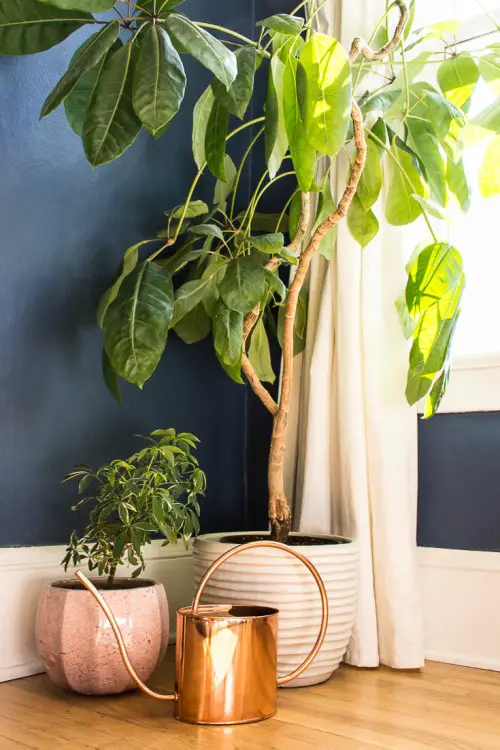Check the soil moisture by inserting your finger about an inch deep. If the soil feels dry, the plant needs water.
Properly watering indoor plants is crucial for their health and growth. Overwatering or underwatering can harm plants and stunt their development. Knowing the right time to water ensures they receive the right amount of moisture. This not only keeps the plants thriving but also prevents issues like root rot or dehydration.
Different plants have varying water needs, so it’s essential to understand the specific requirements of each type. By regularly monitoring soil moisture and understanding signs of thirst, you can maintain a healthy indoor garden. This practice will help your plants flourish and add beauty to your living space.

Credit: diyinpdx.com
Signs Of Thirsty Plants
Knowing the signs of thirsty plants is key to keeping them healthy. Indoor plants give clues when they need water. Below are the main signs that your plant is thirsty.
Wilting Leaves
One of the first signs of a thirsty plant is wilting leaves. The leaves might droop or look lifeless. Wilting leaves lose their firmness and look sad. The edges might curl up, and the color could fade.
Check the leaves often. If they are wilting, it is time to water the plant. But be careful, overwatering can also cause wilting.
Dry Soil
Another sign of a thirsty plant is dry soil. Touch the soil to check its moisture. If it feels dry, the plant needs water.
Use a moisture meter for a more accurate reading. Stick the meter into the soil and see the result. If the meter reads dry, water the plant.
You can also use a simple finger test. Stick your finger into the soil up to your first knuckle. If it feels dry, the plant is thirsty.
| Sign | What to Look For |
|---|---|
| Wilting Leaves | Droopy, lifeless, or curled edges |
| Dry Soil | Soil feels dry to touch or reads dry on a meter |

Credit: www.pinterest.com
Visual Cues
Understanding the visual cues that indicate an indoor plant needs water can save your plants from dehydration. Observing these signs helps maintain plant health and ensures they thrive.
Leaf Color Changes
One of the most telling visual cues is a change in leaf color. Healthy leaves usually appear vibrant and green. If leaves turn yellow or brown, your plant might need water. Brown edges on leaves can also signal dryness. Look for these changes regularly.
Drooping Stems
Another clear sign is drooping stems. When a plant lacks water, its stems may start to sag. Healthy stems should stand upright and firm. Drooping can indicate the plant’s cells are dehydrated. Water the plant and see if the stems perk up after a few hours.
| Visual Cue | Significance |
|---|---|
| Leaf Color Changes | Yellow or brown leaves indicate water shortage. |
| Drooping Stems | Stems sagging mean the plant needs water. |
- Yellow Leaves: Check the soil; it might be dry.
- Brown Edges: Indicates the plant is too dry.
- Sagging Stems: The plant cells lack water.
- Observe the leaf color regularly.
- Check for drooping stems daily.
- Water the plant if these cues appear.
Touch And Feel
Understanding how to tell if an indoor plant needs water is crucial for its health. One effective method is the touch and feel approach. This method involves using your hands to assess the plant’s needs. Let’s delve into some specific techniques.
Soil Texture
The texture of the soil can tell you a lot about its moisture content. Gently press your finger into the soil about an inch deep.
- If the soil feels dry, it’s time to water your plant.
- If it feels moist, the plant does not need water yet.
Also, observe the soil’s surface. If it looks cracked or dusty, the soil is likely dry.
Plant Weight
The weight of the plant pot can also indicate water needs. Carefully lift the pot.
- If it feels light, the soil is probably dry and needs water.
- If it feels heavy, the soil contains enough moisture.
This method works best for smaller pots. For larger pots, use the soil texture method.
Moisture Meters
Moisture meters are essential tools for indoor plant care. They help determine if a plant needs water. This tool can save your plant from overwatering or underwatering. Let’s explore how these devices work and choose the right one for your indoor plants.
How They Work
Moisture meters measure soil moisture levels. They have a probe you insert into the soil. The device gives a reading on a scale. Some scales range from 1 to 10, others from dry to wet. This reading tells you if your plant needs water. It’s a simple, quick, and effective method to monitor soil moisture.
Choosing The Right One
Picking the right moisture meter is crucial. Here are some factors to consider:
- Accuracy: Ensure the meter provides accurate readings.
- Ease of Use: Look for a device that’s easy to read and use.
- Durability: Choose a meter made from durable materials.
- Price: Find one that fits your budget.
| Feature | Importance |
|---|---|
| Accuracy | High |
| Ease of Use | Medium |
| Durability | High |
| Price | Variable |
Moisture meters come in various types. Some have digital displays, others use analog scales. Choose one that suits your needs and preferences. Remember, a good moisture meter can make plant care easier and more effective.
Watering Techniques
Watering indoor plants correctly is crucial for their health. There are two primary watering techniques that plant owners use: bottom watering and top watering. Each has its own benefits and methods. Let’s explore them to understand how to keep your plants hydrated and happy.
Bottom Watering
Bottom watering involves placing the plant’s pot in a container filled with water. The soil absorbs water through the drainage holes at the bottom.
- Fill a tray or basin with water.
- Place the plant pot in the water-filled tray.
- Leave it for about 15-20 minutes.
- Check if the topsoil is moist.
- Remove the pot and let it drain excess water.
This method ensures even moisture distribution. It also prevents over-watering and root rot. It’s perfect for plants with sensitive foliage.
Top Watering
Top watering is the most common technique. It involves pouring water directly onto the soil surface.
- Use a watering can with a narrow spout.
- Pour water slowly around the base of the plant.
- Ensure the water reaches the root zone.
- Stop when you see water draining from the bottom.
- Empty the saucer to prevent water logging.
This method is suitable for most houseplants. It helps flush out excess salts from fertilizers. Make sure to water evenly to avoid dry patches in the soil.
| Technique | Benefits | Best For |
|---|---|---|
| Bottom Watering | Even moisture distribution, prevents root rot. | Plants with sensitive foliage. |
| Top Watering | Flushes out excess salts. | Most houseplants. |
Both watering techniques have their advantages. Choose the method that best suits your plant’s needs. Proper watering keeps your indoor plants healthy and thriving.

Credit: www.reddit.com
Seasonal Variations
Indoor plants need different care in different seasons. Seasonal changes affect how much water they need. Understanding these changes helps your plants stay healthy.
Winter Care
In winter, plants need less water. The air is dry, and growth slows down. Check the soil before watering. If it’s dry an inch deep, then water.
| Winter Care Tips |
|---|
| Water less frequently |
| Check soil dryness |
| Keep plants away from heaters |
Summer Care
In summer, plants need more water. The heat makes the soil dry faster. Check the soil daily. Water if it’s dry two inches deep.
- Water more often
- Mist leaves to increase humidity
- Use a saucer to catch excess water
Common Mistakes
Indoor plants need proper care to thrive. Watering is crucial but often misunderstood. Many plant lovers make common mistakes that harm their green friends. Understanding these mistakes can keep your plants happy and healthy.
Overwatering
Overwatering is a frequent mistake. It can drown your plant roots. This blocks air and nutrients, causing root rot. Always check the soil before watering. Stick your finger into the soil up to the first knuckle. If it feels dry, it’s time to water.
Here are signs of overwatering:
- Yellowing leaves
- Mushy or soft stems
- Moldy soil surface
Stick to a regular watering schedule. Use pots with drainage holes. This helps excess water escape, preventing root rot.
Ignoring Drainage
Ignoring drainage is another common mistake. Good drainage prevents water from pooling at the roots. This is vital for plant health. Use pots with drainage holes. Place a tray underneath to catch excess water.
Here are signs your plant lacks drainage:
- Waterlogged soil
- Root rot
- Stunted growth
Use well-draining soil mixes. Add materials like perlite or sand. These improve soil aeration and drainage.
Expert Tips
Watering indoor plants can be tricky. Experts have tips to help you. They ensure your plants thrive. Let’s explore expert advice on watering plants.
Creating A Schedule
Consistency is key for healthy plants. Creating a watering schedule helps. Use a calendar or set reminders on your phone. Watering schedules depend on plant type and environment. Some plants need water weekly. Others need water every few days.<ul
Sticking to a schedule prevents under or overwatering. It keeps your plants happy and healthy.
Signs Of Overwatering
Overwatering harms plants. Watch for these signs of overwatering:
- Yellowing leaves
- Wilting stems
- Moldy soil
- Root rot
If you notice these signs, reduce watering. Let the soil dry out before the next watering. Ensure pots have drainage holes. This prevents water from pooling at the bottom.
Use these expert tips to care for your indoor plants. Consistency and observation are key. Happy plants make a happy home.
Frequently Asked Questions
How Do I Know If My Indoor Plants Need Water?
Check soil moisture by inserting your finger 1-2 inches deep. Water if the soil feels dry. Drooping leaves also indicate thirst.
How Often Should I Water Indoor Plants?
Water indoor plants once the top inch of soil feels dry. Adjust frequency based on plant type and season.
How Do You Tell If A House Plant Is Over Or Underwatered?
Check the soil moisture level. Overwatered plants have yellow, wilting leaves and soggy soil. Underwatered plants show dry soil, brown, crispy leaves.
How Do You Tell If A Plant Is Not Getting Enough Water?
A plant not getting enough water shows wilting, dry or yellow leaves, and slow growth. Soil may feel dry.
Conclusion
Mastering plant watering ensures healthy indoor greenery. Observe soil moisture, leaf appearance, and pot weight. Consistent care leads to thriving plants. With these tips, you’ll easily keep your indoor plants hydrated. Happy gardening!

My mission is to help you bring the beauty of nature indoors with expert advice, detailed plant care guides, and creative design ideas.





Leave a Reply